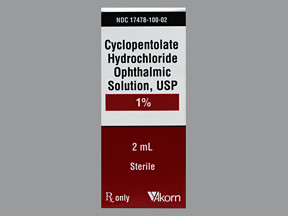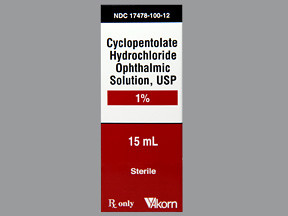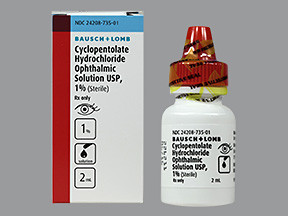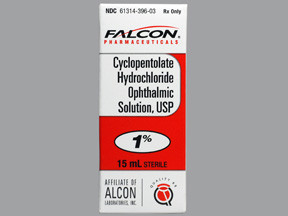CYCLOPENTOLATE HYDROCHLORIDE SOLUTION - OPHTHALMIC
PHONETIC PRONUNCIATION: (SYE-kloe-PEN-toe-late HYE-droe-KLOR-ide)
COMMON BRAND NAME(S): Cyclogyl
GENERIC NAME(S): cyclopentolate HCl
Uses
USES: This medication is used before eye examinations (e.g., refraction exams). It belongs to a class of drugs known as anticholinergics. Cyclopentolate works by temporarily widening (dilating) the pupil of the eye and relaxing the muscles of the eye.
How to use CYCLOPENTOLATE HYDROCHLORIDE SOLUTION - OPHTHALMIC
HOW TO USE: This medication is usually applied in the eye 40 to 50 minutes before the procedure or as directed by your doctor. The dose may need to be repeated in 5 to 10 minutes. This medication is for use in the eye only. Do not take by mouth or inject. To apply eye drops, wash your hands first. To avoid contamination, do not touch the dropper tip or let it touch your eye or any other surface. If you are wearing contact lenses, remove them before using eye drops. Ask your doctor when you can start wearing them again. If you are using another kind of eye medication (e.g., drops or ointments), ask your doctor when you should start using them again. Tilt your head back, look upward, and pull down the lower eyelid to make a pouch. Hold the dropper directly over your eye and place 1 drop into the pouch. Look downward and gently close your eyes for 1 to 2 minutes. Place one finger at the corner of your eye (near the nose) and apply gentle pressure for 2 to 3 minutes. This will prevent the medication from draining away from the eye and reduce side effects. Try not to blink and do not rub your eye. Repeat these steps if your dose is for more than 1 drop or for your other eye if so directed. Do not rinse the dropper. Replace cap after use. If you are using this medicine in a child's eye(s), do not get any medicine in the child's mouth. Wash your hands and your child's hands after use to remove any medicine from them. This medication may temporarily change digestion in infants. Do not feed an infant for 4 hours after the infant's eye exam. This medication starts to work in minutes, and its effect usually lasts 24 hours or sometimes longer. Tell your doctor if you continue to have blurred vision, sensitivity to light, or dilated pupils several days after your exam.
Side Effects
Precautions
Interactions
Overdose
Images
Reviews
Disclaimer
IMPORTANT: HOW TO USE THIS INFORMATION: This is a summary and does NOT have all possible information about this product. This information does not assure that this product is safe, effective, or appropriate for you. This information is not individual medical advice and does not substitute for the advice of your health care professional. Always ask your health care professional for complete information about this product and your specific health needs.






No Reviews Yet